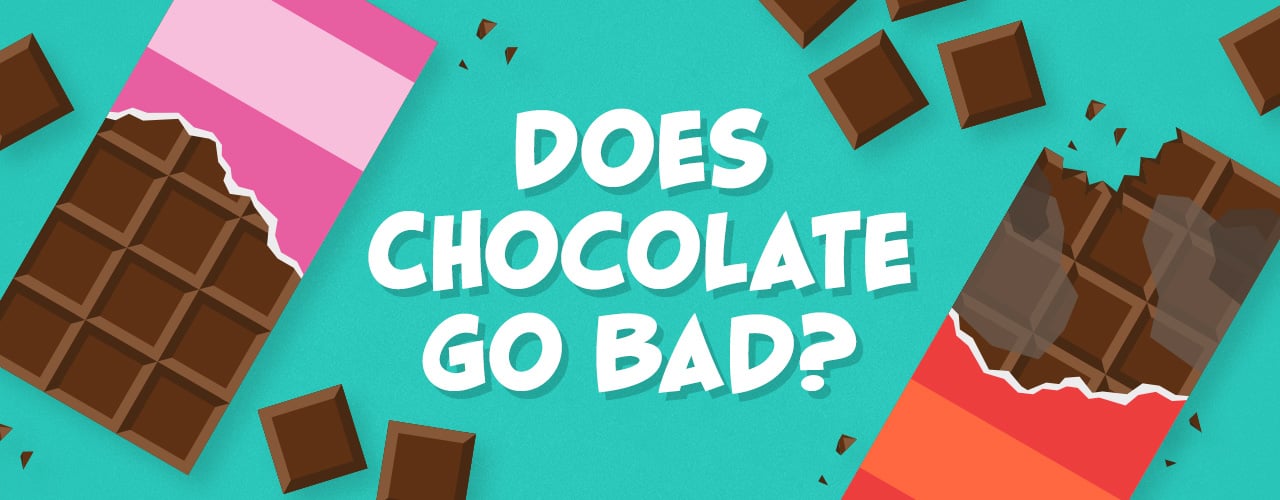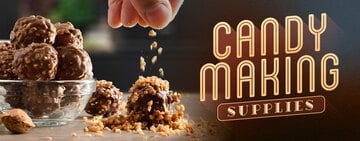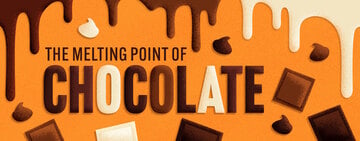Chocolate doesn’t go bad. Yes, you read that correctly! If your chocolate smells/tastes normal and has no mold growth, then it is safe to consume. The best-by date printed on chocolate packaging signifies when its flavor, aroma, and mouthfeel will decline, not when it is inedible. How long chocolate stays in a fresh, potent, and premium condition varies for each type of chocolate.
While chocolate doesn't go bad, there are a few aesthetic and flavor culprits you want to guard against. Heat and moisture alter the appearance and texture of chocolate, but they don't corrupt its flavor. If you bite into a piece of chocolate expecting a delicious treat and receive an unsavory mouthful, your chocolate probably absorbed an environmental aroma. Store chocolate in an airtight container to prevent flavor perversion. We'll answer some of the most common questions about chocolate freshness.
Shop All Bulk ChocolateHow Long Does Chocolate Last?

Because they contain varying amounts of cocoa butter and non-shelf stable additives, dark, milk, and white chocolate have different best-by dates. Below, we explain how long each type of chocolate lasts below.
Does Cocoa Powder Go Bad?
Devoid of fat content, cocoa powder will not go bad. However, it will lose its potency. If unopened and stored in a cool, dry place, cocoa powder keeps a rich flavor for four years. Once opened, cocoa powder is best within the first two years with proper storage.
Do Chocolate Chips Go Bad?
The freshness date of chocolate chips correlates to their type of chocolate. It is a faux pas to store chocolate in the freezer or refrigerator because the changing temperatures and moisture induce blooming. However, if you plan to bake with or temper your chocolate chips, you can extend their freshness date by up to three years by storing them in an airtight container in the freezer and eight months in the refrigerator.
Does Milk Chocolate Go Bad?
Milk chocolate is safe to consume unless it’s molding, but it will lose flavor depth. Unopened milk chocolate stays rich and aromatic for approximately one year after it’s packaged. If opened, use the milk chocolate within eight to ten months. Unless it has an off-putting smell or flavor or has mold growing on it, milk chocolate is safe to consume past its expiration date.
Does Dark Chocolate Go Bad?
Dark chocolate remains in premium condition for two years when unopened and stored in an airtight container away from moisture and heat. If opened but stored in ideal conditions, dark chocolate will keep top quality for about a year. Because dark chocolate doesn’t contain dairy products, it lasts longer than either milk or white chocolate. Like all chocolate, dark chocolate doesn’t go bad or become unsafe to consume (unless visibly molding), but it loses flavor and aroma.
Does White Chocolate Go Bad?
White chocolate is best within six months of packaging when unopened and stored in an airtight container. Opened white chocolate remains fresh for approximately four months. White chocolate is the most sensitive to heat and moisture and is prone to blooming. Store it in a cool and dry place to preserve its appearance.
Do Chocolate Truffles Go Bad?
Chocolate truffles can spoil over time because they're filled with non-shelf stable, moist ingredients. Their delicate structures will lose flavor quality long before they go bad. Chocolate truffles taste best within the first four months of their preparation.
Does Ruby Chocolate Go Bad?
Ruby chocolate (made from ruby cacao beans) is safe to consume unless it molds. However, its berry flavor is most robust within its first year. Consume ruby chocolate within eight months of opening to savor this unique delicacy in its prime. Ruby chocolate’s striking pink hue fades when it’s exposed to sunlight, and it takes on a gray-pink appearance when it’s exposed to moisture or heat.
Can Chocolate Go Bad?
Chocolate can go bad if it’s mixed with less shelf-stable ingredients. While the fat source in chocolate, cocoa butter, is extremely shelf-stable, added flavoring ingredients can expire and make chocolate treats go bad. Chocolate candies with any of the following will have shorter best-by dates and can go bad if not stored properly:
Chocolate Candy Mix-Ins That Can Make Chocolate Go Bad
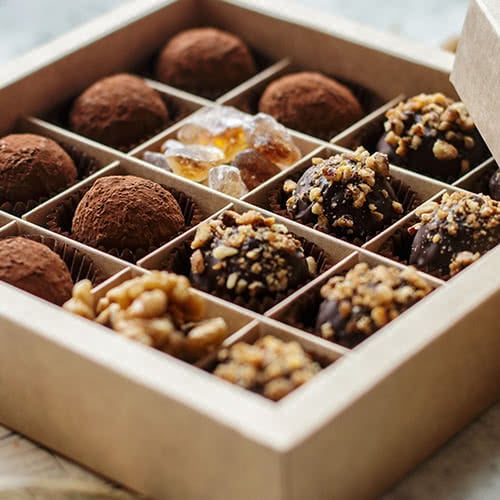
- Dried Fruit
- Caramel/Toffee/Butterscotch
- Nut Butter
- Other Moist/Wet Ingredients
Can Expired Chocolate Make You Sick?
If the expired chocolate doesn’t have mix-ins, it won’t make you sick. Expired chocolate will have a weak flavor but is safe to consume unless it has mold growing on it, has an off-putting smell, or a distasteful flavor.
Does Chocolate Go Bad When It Turns White?
Just because your chocolate has turned white doesn’t mean it is bad. The white film on chocolate is usually just chocolate bloom, a scientific process of fat or sugar in chocolate crystallizing and coming to the surface. Here is how you can tell the difference between mold and bloom:
- Moldy chocolate has white fuzz growing above its surface and will feel fuzzy to the touch.
- Bloomed chocolate has a chalky layer or gray/white streaks on its surface and will feel slick to the touch.
What Is Chocolate Bloom?
Chocolate bloom is the term confectioners use to describe chocolate that appears dusted or streaked with gray. Despite its altered appearance, bloomed chocolate is delicious and safe to consume. Moisture and heat cause chocolate to bloom. Heat alters the fat molecules in chocolate candy, and moisture alters its sugar molecules. Discover the differences between sugar bloom and fat bloom below.
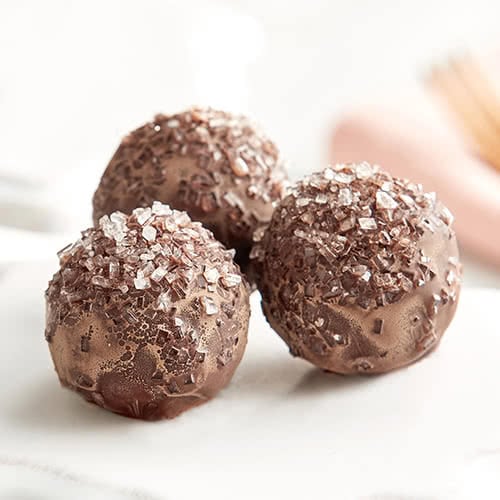
- What Is Fat Bloom? Fat bloom occurs when chocolate is exposed to warm temperatures. Heat causes cocoa butter to soften, separate from the other ingredients, and rise to the surface. When the chocolate re-solidifies, it will have a “bloom” of cocoa butter crystals. Fat bloom looks like a gray cast or white streaks on the surface of the chocolate. It is the most common type of chocolate bloom.
- What Is Sugar Bloom? Sugar bloom occurs when chocolate is exposed to moist environments (ex: humidity or refrigeration). Moisture causes sugar content to evaporate and form large sugar crystals on the surface of chocolate. Sugar bloomed chocolate can either look crystallized or dusty.
How to Fix Chocolate Bloom
Since chocolate bloom occurs when the fat or sugar in chocolate candy rises to the surface, you can fix chocolate bloom by reincorporating the fat or sugar into the chocolate. To fix chocolate bloom, melt the chocolate, stir it, pour it into a mold, and allow the chocolate to re-harden. It will re-solidify into unbloomed chocolate.
Does Chocolate Bloom Affect Taste?
Chocolate bloom doesn’t affect either the taste or shelf life of chocolate. The only difference between bloomed and unbloomed chocolate is its appearance. If you don’t want to sell bloomed chocolate because of its reduced aesthetic appeal, melt bloomed chocolate and use it to make bakery items like chocolate-dipped macaroons.
Can You Eat Bloomed Chocolate?
You can safely eat and enjoy bloomed chocolate. It will taste the same as its unbloomed counterparts.
How to Store Chocolate?
Store your chocolate in a sealed food storage container in your pantry to preserve its flavor and appearance. Sealing chocolate inside a storage container prevents flavor absorption. Both heat and moisture induce chocolate bloom, which is a cosmetic rather than a flavor problem, but customers may be unhappy with the appearance of bloomed chocolate. Never store your chocolate in the moisture-rich refrigerator or freezer unless you’re planning to bake with it. Review our chocolate storage tips below to learn how to store chocolate.
- Seal chocolate in an airtight container. Cocoa butter absorbs the flavor of whatever is nearby, so sealing chocolate preserves flavor integrity. Airtight containers also block out oxygen, which causes chocolate to oxidize and develop unappetizing flavors.
- Store chocolate in a cool and dry environment. Heat and moisture cause cosmetic damage known as chocolate bloom. Cool, dry environments with humidity lower than 55 percent and temperatures ranging between 65 and 68 degrees Fahrenheit will keep the emulsion of cocoa butter and cocoa solids shelf-stable.
- Keep chocolate away from light. Both sunlight and artificial light induce oxidation. Ruby chocolate loses some of its sought-after pink hue when it's exposed to direct light.
- Don’t refrigerate the chocolate you want to serve. Moisture in the refrigerator causes sugar bloom and reduces your chocolate’s aesthetic appeal. Since chocolate absorbs aromas, chocolate stored in the fridge may take on the flavor of your proteins and produce.
- You can use a wine fridge to store chocolate before shipping it. To ship chocolate and have it arrive intact, you want it to be as cold as possible. Wine refrigerators are not as cold as regular refrigerators and won’t cause sugar crystal bloom. Seal your chocolate before placing it in the wine fridge to prevent cross-flavor absorption.
- The freezer can extend flavor and aroma quality in chocolate. The changing temperatures and moisture may induce bloom, so only use this method for chocolate you plan to melt. Seal the chocolate before adding it to the freezer to prevent flavor perversion.
- How to freeze and defrost frozen chocolate without altering its texture: Temperature shock can alter the texture of chocolate. To prevent this, first move the chocolate to the refrigerator for 24 hours before adding it to your freezer. When it’s time to defrost the chocolate, put it in the refrigerator for 24 hours. Finally, let it come to room temperature before unwrapping it.
Chocolate rarely rots and becomes inedible, making it an excellent ingredient for your kitchen. However, chocolate loses flavor and aroma potency over time, and improper storage can lead to aesthetic disfiguration and flavor perversion. Reference back to this guide at any point to determine how long each type of chocolate remains in its prime, how to fix chocolate bloom, and how to store chocolate.
